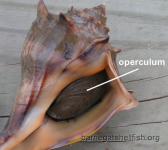|
Whelks are large
marine snails (gastropods)
with spiral shells. They are both are scavengers
and carnivores and travel along (or just under)
the bay bottom in search of clams and other
shellfish.
 Whelks
grow by using their
mantle to produce calcium carbonate to
extend their shell around a central axis or
columella,
producing turns, or whorls, as they grow. A
whorl is each spiral of the shell. Whelks
grow by using their
mantle to produce calcium carbonate to
extend their shell around a central axis or
columella,
producing turns, or whorls, as they grow. A
whorl is each spiral of the shell.
The final whorl,
and usually the largest, is the body whorl that
terminates, providing the aperture into which
the snail can withdraw.
<click on any image to
enlarge>
Whelks also have a
separate hard, horny plate, called an operculum,
which acts like a trap door when the snail
withdraws into the shell. Sometimes called a
“shoe,” the operculum is attached to the top of
the living animal’s foot.
<see lower right image>
Whelks are
subtidal animals,
meaning they lives only below the low tide
 mark.
because their operculum does not tightly seal the
opening of the shell it cannot survive being
exposed to the air as some intertidal animals
(like mussels) can. mark.
because their operculum does not tightly seal the
opening of the shell it cannot survive being
exposed to the air as some intertidal animals
(like mussels) can.
When hunting prey,
they travel along the bay bottom using their
strong foot and use their nose (or proboscis) to
find these buried animals by sensing the stream
of water flowing out of the clam’s feeding
tubes.
Once its prey is
located the whelk digs down into the bay bottom to
capture it.
Feeding
Method 1 - Whelks use their
shell’s lip to chip and pry the
valves of bivalves
(i.e. clams) apart by holding it with its foot so that
the ventral edges
of the prey’s valves are under the outer lip of
the whelk’s shell. This is similar to
using a clam knife to shuck (open) a hard clam.
Slow chipping
continues until an opening occurs to allow the
whelk to wedge its shell between the clam’s
valves. When there is sufficient room, it
extends its proboscis (with mouth at the end) to begin feeding.
Method 2 -
Another method of getting at a food source
(especially if the victim is not a bivalve) is
that once the prey is immobilized, the whelk
extends its proboscis which is equipped with a
mouth and a tooth-like
radula at the end.
<click here
for more radula details>
The whelk has a
gland that secretes a chemical that softens
calcium carbonate so the radula can efficiently
be used to bore a hole in the shell of the prey.
When the drilling
process is completed, the whelk extends its
proboscis into the prey and begins feeding.
|
